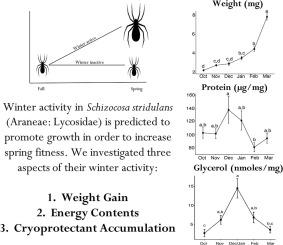Journal of Insect Physiology ( IF 2.3 ) Pub Date : 2020-09-03 , DOI: 10.1016/j.jinsphys.2020.104112 Leslie J Potts 1 , Vladimir Koštál 2 , Petr Simek 2 , Nicholas M Teets 1

|
Winter provides many challenges for terrestrial arthropods, including low temperatures and decreased food availability. Most arthropods are dormant in the winter and resume activity when conditions are favorable, but a select few species remain active during winter. Winter activity is thought to provide a head start on spring growth and reproduction, but few studies have explicitly tested this idea or investigated tradeoffs associated with winter activity. Here, we detail biochemical changes in overwintering winter-active wolf spiders, Schizocosa stridulans, to test the hypothesis that winter activity promotes growth and energy balance. We also quantified levels of putative cryoprotectants throughout winter to test the prediction that winter activity is incompatible with biochemical adaptations for coping with extreme cold. Body mass of juveniles increased 3.5-fold across winter, providing empirical evidence that winter activity promotes growth and therefore advancement of spring reproduction. While spiders maintained protein content throughout most of the winter, lipid content decreased steadily, suggesting either a lack of available prey to maintain lipids, or more likely, an allometric shift in body composition as spiders grew larger. Carbohydrate content showed no clear seasonal trend but also tended to be higher at the beginning of the winter. Finally, we tested the hypothesis that winter activity is incompatible with cryoprotectant accumulation. However, we observed accumulation of glycerol, myo-inositol, and several other cryoprotectants, although levels were lower than those typically observed in overwintering arthropods. Together, our results indicate that winter-active wolf spiders grow during the winter, and while cryoprotectant accumulation was observed in the winter, the modest levels relative to other species could make them susceptible to extreme winter events.
中文翻译:

越冬的狼蛛Schizocosa stridulans的能量平衡和代谢变化。
冬季给陆生节肢动物带来了许多挑战,包括低温和粮食供应减少。大多数节肢动物在冬季处于休眠状态,并在条件有利时恢复活动,但少数几个物种在冬季仍保持活跃。冬季活动被认为是春季生长和繁殖的开端,但很少有研究明确检验这一想法或研究与冬季活动有关的权衡取舍。在这里,我们详细介绍了越冬的冬季活跃的狼蛛Schizocosa stridulans的生化变化,检验冬季活动促进生长和能量平衡的假说。我们还量化了整个冬季假定的防冻剂的水平,以测试有关冬季活动与应对极端寒冷的生化适应措施不兼容的预测。在整个冬季,少年的体重增加了3.5倍,这提供了经验证据,表明冬季活动促进了生长,从而促进了春季繁殖。尽管蜘蛛在整个冬季的大部分时间内保持蛋白质含量,但脂质含量却稳定下降,这表明要么没有可用的猎物来维持脂质,要么更有可能是随着蜘蛛的成长,身体成分发生了异形变化。碳水化合物含量没有明显的季节性趋势,但在冬季开始时往往较高。最后,我们检验了冬季活动与防冻剂积累不相容的假说。然而,我们观察到甘油,肌醇和其他几种冷冻保护剂的积累,尽管其含量低于节肢动物越冬通常观察到的水平。总之,我们的结果表明,有冬季活动能力的狼蛛会在冬季生长,虽然在冬季观察到了防冻剂的积累,但相对于其他物种而言适度的水平可能会使它们容易受到冬季极端事件的影响。











































 京公网安备 11010802027423号
京公网安备 11010802027423号